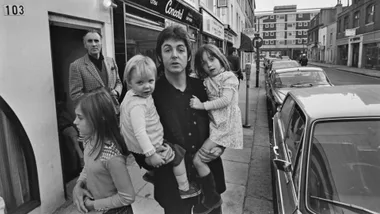Clicky hips are one of the most common abnormalities in newborns.
The condition affects 1 to 3 percent of newborns. If your baby is affected, the sooner the condition is identified the more likely it is that treatment will be successful.
The medical name for clicky hips is congenital dislocation of the hips (CDH).
The hip is made up of a ball, formed by the end of the thighbone (femur) and socket joint, formed by the pelvis.
If the socket is not properly formed, the ball tends to slip out or dislocate, making a slight click when the hip is moved.
Clicky hips are often inherited, and girls are affected more than boys.
MORE READING: Busting those fertility myths …

Clicky hips are one of the most common abnormalities in newborns, affecting more girls than boys.
What causes clicky hips?
CDH is more common in breech babies and babies who have been tightly squashed in the uterus due to lack of space.
For this reason, it’s more common in first-born babies as the uterus tends to be tighter the first time around.
It is also more common in girls, due to the female hormones which can cause the joint to be more lax.
CDH also tends to run in families. So if one girl in the family has CDH, the chances are that her sisters will, too.
If it is detected early it can be successfully treated. But if it is only discovered when your child starts to walk with a limp it is more difficult to treat and may need surgery.
MORE READING: Safe co-sleeping …

All babies are checked for CDH at birth.
How can I tell if my child has clicky hips?
All babies are checked for CDH at birth. If his hips make a distinctive click, or if your paediatrician is in any way concerned because, say, his leg creases seem uneven, he’ll be checked again within a few days.
There are varying degrees of CDH and it can occur in either one or both hips.
An ultrasound scan will be done if there are still concerns about his hips. This scan gives a clear picture of the hip joint.
In some hospitals, all babies born with the three main risk factors for CDH (breech birth, a family history of CDH or congenital abnormality) are screened by ultrasound.
Early diagnosis is important as it gets harder to examine as your child grows bigger and stronger.
In children with CDH who are not diagnosed at birth, it will show up when he begins to walk. He will probably walk late and may have a limp or an unsteady walk.
Your baby’s hips will be checked throughout his first year, so it’s important not to miss his health checks. However, some babies are born with hips that seen normal, but which then don’t develop properly. In which case, you may be the first to pick up the signs.
You may notice that:
One leg looks slightly longer than the other
Extra skin creases on one thigh or buttock
As you change his nappy, one hip may not open as much as the other
In rare cases, he may start to walk with a limp or walk on his toes on the affected side
Continues after video …
How are clicky hips treated?
A lightweight splint will be fitted that pushes his legs apart and keeps his hips in position. It will usually be put on within a few days of the diagnosis. But you may be asked to use double nappies on him until then, which will act like a temporary splint.
The splint is worn under his clothes and left on for the duration of his treatment – around six to 12 weeks.
Some babies may need to have traction to position their hips properly first. This tends to happen with toddlers or older children who are diagnosed later.
If the splint doesn’t work, he may have to wear a plaster cast. But first he may have to spend some time in traction in hospital to reduce the chance of complications developing.
The cast is put on under general anaesthetic and worn for six weeks.
If his hip is still unstable after this time, the cast may be re-applied for as long as nine months.
Sometimes children need surgery before the plaster cast is put on. Surgery is usually carried out on older children if other treatment methods have failed or if the diagnosis was made too late for any other treatment to be effective.
READ MORE: All about ear infections in babies and children …

If your baby is affected, the sooner the condition is identified the more likely it is that treatment will be successful.
Coping with a baby in splint or plaster cast
If he is wearing a plaster cast, he will be extremely heavy and hard to cuddle, so you’ll need to find other ways to hug him.
There are a number of steps you need to take if your child is wearing a splint:
Feeding:
You can breastfeed, but you’ll need to experiment with pillows to help support him and the splint. Young babies may find it hard to bring up wind because the splint stops them from drawing their legs up. If he’s in a high chair, you may have to cut out the side so that he can straddle it.
Sleeping:
You may have to remove some the cot bars to allow his legs to stick out. He’ll need fewer covers because plaster is hot.
Hygiene:
Use larger nappies than he needs. Combine them with disposable pants, to hold the nappies in place. Change him frequently to keep the splint or plaster clean.
Washing:
You will not be able to bathe him while he is in a splint or plaster, so you’ll need to wash him using sponge or flannel. Also check for any signs of soreness caused by the plaster.
Dressing:
Buy clothes a couple of sizes too big for him and always with poppers or Velcro.
Transport:
A larger than usual pram or buggy is ideal, but he won’t fit into a conventional child car seat. A booster seat may do for a toddler, but a small baby may need to have his seat adapted.







.png?resize=380%2C285)


